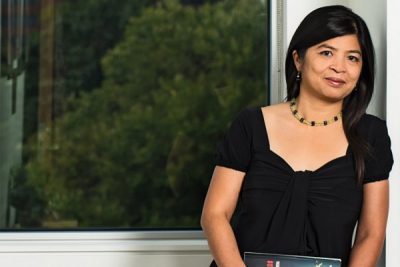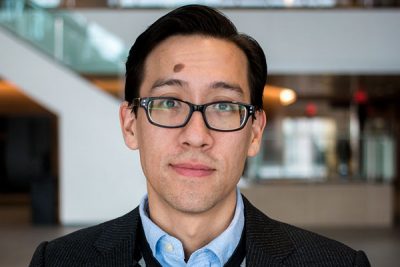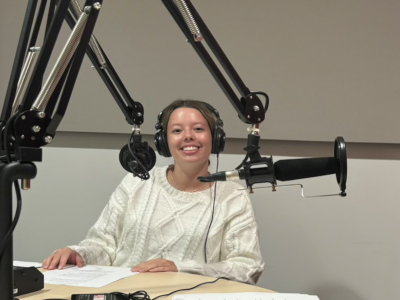Four faculty members in the Communication and Media Studies program received substantial research grants from the Social Sciences and Humanities Research Council of Canada (SSHRC) this week.
On Nov. 15, SSHRC announced the winners of its Insight Development Grant, Insight Grant and Partnership Development Grant competitions. Among the list of recipients are Rena Bivens, Merlyna Lim, Sarah Smith, and Benjamin Woo, whose projects received a cumulative total of over $400,000 in funding.

Dr. Rena Bivens, Assistant Professor
Rena Bivens
Award received: SSHRC Insight Development Grant
Research project: “Imagining the Future with Speculative Design: Reconfiguring How We Think, Talk, and Intervene in the Problem of Sexual Violence”
What does your project look at?
My project asks questions about how we might begin to think differently about preventing sexual violence, using speculative design as a method to bring together experts from the sexual violence community, including Ottawa-based community practitioners, academic experts and app developers who are building technology that tries to assist in preventing sexual violence. This research builds off of a previous project I completed with Amy Hasinoff in which we looked at over 200 different apps designed to prevent sexual violence. Unfortunately, we were not terribly excited by what we found. The goal of this project is not to create a new, better app, but to think about the future in order to help us reconfigure what is important when it comes to preventing sexual violence.
What led you to pose these particular questions?
Speculative design is a method that really interests me. I like that it’s creative, that it has a potential to interrupt dogmatic ways of thinking and force us into a different, future setting where we can let go of things that we normally hold onto. It helps us take the blinders off. Amongst sexual violence experts, there are a lot of contentious issues when it comes to sexual violence prevention. A method like speculative design offers an exciting way to try to talk about this difficult subject.
Why is this research important?
It sometimes feels like nothing is changing with regards to sexual violence, and that can be frustrating, overwhelming and depressing. It feels like we have all the tools to solve or at least alleviate some of the problems of sexual violence, but the ways in which we talk and think about sexual violence seems to stop us from implementing them. Still, each day we see new allegations coming out of Hollywood. Something is building in the way we’ve been talking about sexual violence differently in public discourse lately. I want to work with that momentum and push it harder.
Shaunel London, Research Assistant and MA Student
What has your experience been like working on this project?
So far, it’s been really interesting to see how current technological solutions are often entangled in sexual violence myths, and I’m excited to challenge it through this research. For example, I am currently exploring how technology and sexual violence discourse have evolved together throughout history. I also feel really lucky to be part of this process from the beginning, I know I’m gaining invaluable research experience.
Why is this research important?
Using speculative design, which is a relatively new method, is so integral to why this research works because it’s all about the knowledge exchange that will inform us as researchers, as well as the participants. It brings together two different groups with the intent to think about technological sexual violence solutions that aren’t constrained by what can be done in the present, but is enlarged by what can be imagined.
Carla McCutchin, Research Assistant and PhD Student
What has your experience been like working on this project?
Although we’ve been working on this project since August, it feels as though it has just gotten started because everything is falling into place. It’s exciting to see a project coming together and patterns beginning to emerge from the literature.
Why is this research important?
This project is important because our aim is to bring app developers and sexual violence experts together, and to facilitate knowledge sharing amongst individuals in two very different disciplines of thought. I’d also say that it’s important because we are not focusing on technological solutions to sexual violence, but are instead exploring knowledge sharing as a key way to address future solutions.

Dr. Merlyna Lim, Associate Professor and Canada Research Chair in Digital Media and Global Network Society
Merlyna Lim
Award received: SSHRC Insight Grant
Research project: “Cyber-urban space, social media, and contemporary social movements in Southeast Asia”
What does your project look at?
This research argues for a more spatially sensitive understanding of the relationship between social and social movements. The core research question is: How is social media utilized in the production of alternative spaces for activism and counter-hegemonic projects? In answering this question, the project takes on spatial and historical analysis to offer an in-depth understanding of the relationship between social movements, social media and actions on the ground. Using empirical evidence from Southeast Asian context, namely Indonesia, Malaysia, and the Philippines, the research will generate conceptual and theoretical frameworks of the dialectical interplay between social media and physical spaces in the making and doing of contemporary social movements.
What led you to pose these particular questions?
From the Bersih movement in Kuala Lumpur to the anti-extrajudicial killing protest in Manila, in the last decade we have witnessed numerous protests and mass movements take place across the globe. The causes, goals, and relative success or failure of each differ. But each event was intricately networked through the use of social media and each materialized in the mass occupation of public urban spaces. Although these commonalities are widely known, the connection between these two features remains inadequately studied. How can we better understand the interplay between social media and the occupation of urban spaces? How do spaces contribute to insurgent activities and social movements? To what extent do contemporary movements need both cyberspace and physical space to assert influence within a political state?
Why is this research important?
The project aims to enhance the existing theories on social movements, digital media, and urban spaces as well as to form, facilitate, and maintain an interdisciplinary discourse on this topic, especially between communication research and urban research. Further, it also provides provide students, scholars-in-training and any academics who are involved in the project through various means (e.g. workshop and public lectures) with a broader understanding of the cyber-urban reflexive relationship in contemporary social movements and of the need for both empirical research and new theory in this field. Beyond academia, the project aspires to facilitate public discourse on social media activism in a manner that would empower marginalized communities/movements.

Dr. Sarah Smith, Assistant Professor
Sarah Smith
Award received: SSHRC Insight Development Grant
Research project: “Exhibiting International Values: The Cultural Diplomacy of UNESCO’s Museums Division”
What does your project look at?
My project looks at UNESCO’s role to coordinate museum work internationally in the second half of the twentieth century. The focus of my research is on the activities of UNESCO’s Museums Division (which took various titles over the years). This unit promoted museums and connected institutions and professionals internationally. Questions shaping my research include: how did the Museums Division establish and promote specific norms and procedures within the field of museology? What policies did the unit implement, and how did these promote specific definitions of heritage and its value amongst member states? There is also a Canadian angle to my project. I will trace the transnational networks of curators and administrators UNESCO facilitated and how these might have impacted the creation and implementation of Canadian museum organizations and cultural policies.
What led you to pose these particular questions?
This project comes out of research completed during my Banting Postdoctoral Fellowship. It is also influenced by my interest in cultural diplomacy and international cultural relations. I am curious about the history of museum diplomacy, and think UNESCO’s work provides an important context to understanding the current diplomatic function of museums.
Why is this research important?
Lately there has been acknowledgement that museums play an important cultural diplomacy role, connecting disparate groups and facilitating exchange and dialogue. My project seeks to ground this understanding in a larger context, suggesting that museums and exhibitions have long exerted soft power to foster state coalition building and conversations between publics. I hope my research can add to the understanding of the established role of museums as cultural brokers in the global sphere.

Dr. Benjamin Woo, Assistant Professor
Benjamin Woo
Award received: SSHRC Partnership Development Grant
Research project: Comic-cons: an emerging urban media industry
What does your project look at?
Our project is about comic cons, comic art festivals, and related fan events. Over the last decade or so, these events and the organizations that run them have grown immensely—in fact, the format is being copied in a wide range of other industries, from trade publishing to craft brewing and the “wellness” sector. However, we don’t yet know much about them. We’re going to attempt to map the sector and build an interactive, public event directory, as well as conduct organizational ethnographers with our partner events, the Toronto Comic Art Festival and the Ottawa Geek Market.
What led you to pose these particular questions?
My previous research on local geek media cultures underscored the importance of intermediaries and infrastructures for the on-going vitality and vibrancy of popular cultures. For a whole range of media genres and fan communities, cons play that crucial infrastructural role. But while it’s hard to miss comic cons these days, the academic literature on them is pretty one-sided. It’s almost all written from a consumer-facing, attendee perspective because that’s what researchers have been able to access. We pursued a partnership approach, working with actual convention and festival organizations in addition to a team of amazing researchers, in order to try to pull back the curtain on how these events are put together, how they negotiate between the interests of different stakeholders, and how they contribute to the cultural life of the cities where they’re located.
Why is this research important?
The convention sector is a media industry with an estimated economic impact in the billions of dollars, but it’s largely flown under the radar of policymakers and granting agencies. We want to measure the impacts of these events, share best practices, and better understand how they enable all kinds of cultural and economic activity so that convention organizers can better articulate their needs and contributions to sponsors, funders, and governments.
Sunday, November 19, 2017 in Communication News, News, Research
Share: Twitter, Facebook



